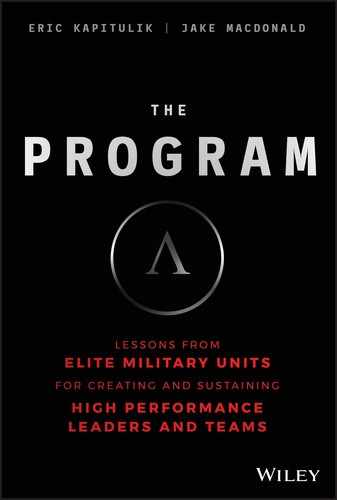10
A Commitment to Goals and Standards
WE HAVE SEEN numerous examples of a great parent, coach, or business leader creating a world-class championship culture through sheer force of will. They refuse to accept mediocrity and single-handedly carry the entire organization to the mountaintop. It is incredibly physically, mentally, and emotionally challenging to bring the team there, but a physically, mentally, and emotionally tough leader can do it (more on developing these attributes in Section 4). However, sustaining a world-class championship culture over the long term takes a commitment from the entire team. World-class organizations have world-class cultures whose foundation is its “best” people. We then must provide structure to those “best” people where they can develop and then perform at their best. That structure is defined by our goals and standards. Finally, world-class organizations are committed to achieving those goals and standards. The leader is not the only one committed. Although we can do it alone, we cannot sustain it alone; it requires the entire organization. To create this commitment, we must give ownership to our “best” people, those team members who have talent and embody our organization’s Core Values. We consistently hear coaches and business leaders agree that to be successful or to become even more successful, the team must be more committed. They correctly surmise that providing “ownership” of the team to the members of it helps them be more committed. Leaders typically attempt to accomplish this by allowing team members to decide where they want to eat while on the road. Unfortunately, this does not give them ownership; it merely makes them food critics! To create ownership, we must first identify our Core Values, explain how we define them for our organization, and then identify those individuals who best embody them. At that point, we can task our “best” people with creating the goals and standards that reinforce those Core Values. These are the goals and standards to which they first want to be held. Second are the goals and standards to which they will hold each other, and finally those to which they want to hold their teammates accountable. We allow and foster ownership by selecting and tasking those players or employees whom we view as “best” to determine our organization’s goals and standards. All of us love ownership, especially the “best” people. Give it to them! If our best people, and then the team, own the goals and standards, they own the team’s culture. The “best” people appreciate the trust we put in them to determine what the goals and standards should be. They are more committed to enforcing and reinforcing them because these are the goals and standards that they said they wanted! They are their goals and standards. Leaders often question this approach. What if the best people set goals and standards that are too low? We appreciate the concern. However, numerous clients who tried this approach have reported back to us that not only did their “best” not set too low of goals and standards, but rather provided ones that were unrealistically high for anyone on the team other than the “best.” The leaders had to introduce a bit of “reasonable person theory” into the discussion about what the team’s goals and standards should be. Leaders do this by making goals and standards more “gateway,” meaning slightly lower standards at the start that act as gateways to higher ones in the future. Our “best” people don’t want to associate with anything, or anyone, who is also not the best. Lions hang out with lions, zebras with zebras. We ensure an unprecedented commitment level to our organization and the goals and standards that reinforce our culture, our Core Values, by giving true ownership of the team to the team’s “best” people. We do so by allowing our “best” to determine the goals and, more importantly, the standards to which they will hold themselves first and then their teammates (including the leaders).
